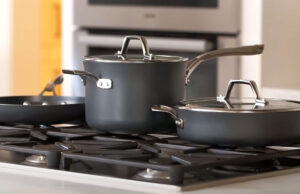As an Amazon Associate, I earn from qualifying purchases at no extra cost to you.
How to Secure Whirlpool Dishwasher to Cabinet the Easy Way
You slide the dishwasher in, but it wobbles, tilts, or just feels unsafe. Frustrating, right? That little shake every time the door opens can make you nervous about leaks or scratches. In this article, we’ll tackle that exact problem and show you how to secure your Whirlpool dishwasher to your cabinet. You’ll feel confident and safe in minutes, even if this is your first time. Let’s get it snug and perfect!
First, you’ll need the right tools and screws. Always check your dishwasher model for installation guidelines. Leveling the dishwasher ensures it sits evenly and works properly. Attach the brackets to the cabinet carefully to avoid damage. Tighten everything just enough, not too much, to prevent warping. Test the door’s movement and stability. Finally, double-check water and power connections.
Prepare Your Workspace and Gather Tools
Before you start, clear the area around your dishwasher completely. Pull it out carefully and remove any packaging or protective foam. Make sure the floor under the dishwasher is clean and dry to avoid slipping or scratches. This step helps you work safely and keeps the dishwasher in perfect condition.
Next, gather all the tools you’ll need. You’ll typically need a screwdriver, adjustable wrench, level, tape measure, and the mounting brackets provided by Whirlpool. Double-check your dishwasher’s manual to see if any special tools are recommended. Having everything ready makes the process smoother and prevents frustration mid-installation.
Check the cabinet for any obstructions. Look for uneven surfaces, protruding nails, or old screws that might interfere with securing the dishwasher. If necessary, fix any minor issues before proceeding. This ensures a snug fit and prevents future wobbling or damage.
Once your workspace is ready, place the dishwasher close to the cabinet but don’t slide it in yet. This positioning allows you to access the mounting points easily. Keep all screws and brackets within reach to avoid constant bending or stretching.
- Clear the workspace and remove packaging
- Gather tools and mounting brackets
- Inspect the cabinet for obstructions
- Position dishwasher close but not fully in
Level the Dishwasher for Perfect Alignment
Leveling is crucial for a dishwasher to function well. Even a small tilt can cause water to pool or the door to not close properly. Start by placing a bubble level on top of the dishwasher front to back and side to side. This tells you if the appliance is perfectly horizontal.
Adjust the legs under the dishwasher carefully. Most Whirlpool models have adjustable legs you can twist to raise or lower the height. Make small adjustments and check the level frequently. This ensures stability and prevents future damage to the dishwasher or floor.
Once the front is level, check the back. Some floors may be slightly uneven, so you may need to adjust rear legs differently than the front. Take your time—rushing can lead to tilting, which affects performance and safety.
After leveling, gently push the dishwasher toward the cabinet without forcing it. Keep checking that it stays level as it moves. A properly leveled dishwasher makes installation much easier and ensures smooth operation.
- Use a bubble level front to back and side to side
- Adjust the legs slowly and carefully
- Check rear alignment on uneven floors
- Push toward the cabinet while maintaining level
Attach Mounting Brackets Securely
Now it’s time to attach the brackets that hold the dishwasher to the cabinet. Locate the pre-drilled holes on the top or side of the dishwasher. Make sure they align with the cabinet frame. This alignment is critical for a firm hold.
Use the screws provided by Whirlpool to secure the brackets. Start them by hand to ensure correct threading, then tighten with a screwdriver. Avoid over-tightening, which can strip the screws or damage the cabinet. A snug fit is what you want.
If your cabinet has a face frame, you may need to use longer screws to reach through it. Carefully check that the screws are not going into electrical wires or plumbing behind the cabinet. Safety first—nothing should get pinched or damaged.
Once the brackets are secure, give the dishwasher a gentle shake to test stability. It should not move noticeably. If there is any wobble, check bracket alignment and screws. Properly secured brackets are key to preventing future accidents or leaks.
- Align pre-drilled holes with cabinet frame
- Start screws by hand, then tighten carefully
- Use longer screws for face frame cabinets if needed
- Test stability before finishing
Connect Water and Power Safely
Before fully pushing the dishwasher in, connect the water supply line. Turn off the main water valve first to avoid leaks. Attach the line to the dishwasher inlet and tighten using an adjustable wrench. Don’t over-tighten, as this can damage the fittings.
Next, connect the drain hose to the sink drain or garbage disposal. Make sure it forms a high loop to prevent backflow. Secure with a clamp or fastener as per the manual. Double-check for kinks or bends that may block water flow.
Finally, plug in the dishwasher. Ensure the power outlet is grounded and matches your dishwasher’s requirements. Keep cords away from water sources to prevent accidents. Test the dishwasher with a short cycle to check water connections and overall function before pushing it fully into place.
- Turn off main water supply
- Connect water line and tighten properly
- Attach drain hose with high loop
- Plug in and test briefly
Slide Dishwasher Into Cabinet and Finalize
Gently slide the dishwasher fully into the cabinet space. Watch the sides to avoid scratching walls or cabinets. Adjust slightly as needed to keep the dishwasher aligned with the surrounding cabinetry. Smooth, careful movement avoids damage.
Check the front panel to ensure it lines up with cabinets. Minor shifts can be corrected by slightly adjusting the legs or repositioning. This gives a polished, professional look.
Tighten the mounting brackets one last time to ensure everything is secure. Double-check the level and stability again. Close the door to confirm it opens and shuts smoothly without rubbing or resistance.
- Slide dishwasher carefully into space
- Align front panel with cabinets
- Retighten mounting brackets
- Verify door operation and stability
Inspect and Test for Safe Operation
Before calling it done, run a full cycle on the dishwasher. Watch for leaks at water connections and check that the door stays stable during opening and closing. This confirms everything is secure and functional.
Inspect underneath the dishwasher and behind the brackets for any movement or unusual noise. Tighten screws or adjust legs if necessary. Regular maintenance checks help prolong the life of your appliance and prevent damage.
Make sure the dishwasher doesn’t rock or tip. Even slight movement can lead to long-term wear or leaks. Adjust and test until it remains perfectly stable. A solidly secured dishwasher is safer, quieter, and works more efficiently.
- Run a complete wash cycle
- Watch for leaks or noise
- Check under and behind brackets
- Adjust for perfect stability
Final Thoughts
Securing your Whirlpool dishwasher to a cabinet doesn’t need to be stressful. With careful leveling, proper bracket attachment, and safe water connections, you get stability and peace of mind. Testing it ensures no leaks or wobble. In a few simple actions, your dishwasher can be safe, efficient, and look like it was installed by a pro. Enjoy the confidence of a sturdy appliance that lasts.
| Task | Details | Tools Needed | Tip |
|---|---|---|---|
| Clear workspace | Remove packaging, clean floor | None | Prevents damage |
| Level dishwasher | Use bubble level | Adjustable wrench | Check front & back |
| Attach brackets | Align and secure screws | Screwdriver | Hand-tighten first |
| Connect water | Attach line & drain hose | Wrench | High loop for drain |
| Slide in | Align panel | None | Move gently |
| Test | Run cycle, check stability | None | Adjust if needed |
Frequently Asked Questions (FAQs)
Is it necessary to level my Whirlpool dishwasher before installation?
Yes, leveling is very important. A dishwasher that isn’t level can cause water pooling, uneven cleaning, or strain on the door. Even a small tilt affects performance over time. Using a bubble level front to back and side to side ensures your dishwasher sits perfectly. Adjust the legs slowly and recheck until fully level. This step protects your appliance and prevents leaks or wobbling. A properly leveled dishwasher also ensures quieter operation and reduces long-term wear on internal parts. It may take a few tries, but the results are worth it.
Can I use any screws to secure the dishwasher to the cabinet?
No, it’s important to use the screws provided or recommended by Whirlpool. Generic screws may not hold the weight or could strip the mounting points. Using the correct screws ensures a firm and safe attachment. Over-tightening can damage both the cabinet and dishwasher frame. If your cabinet has a thick face frame, longer screws may be necessary, but they must still match the manufacturer’s specifications. Always check the manual before starting. Proper screws ensure stability, safety, and long-term reliability of your appliance.
Do I need to disconnect water before attaching the dishwasher?
Yes, always turn off the main water supply before making any connections. This prevents leaks, flooding, or damage. Even a small drip can create slippery floors or water damage under cabinets. After turning off the water, attach the supply line carefully, tightening with a wrench just enough to seal. Make sure the drain hose is connected with a high loop to avoid backflow. Safety first ensures smooth installation and protects your home.
Is it okay if the dishwasher wobbles slightly after installation?
No, any wobble can lead to long-term issues. Even a small movement can stress plumbing connections, scratch cabinets, or wear out internal components. If there is wobbling, check the leveling and mounting brackets. Adjust legs slowly and retighten screws. Every dishwasher should sit firmly with no noticeable movement. A stable appliance ensures better cleaning, quieter operation, and reduces risk of damage or leaks.
Can I install the dishwasher without sliding it out first?
It’s not recommended. Pulling the dishwasher out allows full access to the mounting points, legs, and connections. Working with it fully pushed in increases risk of misalignment, scratches, or improper water connection. Sliding it out first ensures safe handling, proper leveling, and easier bracket attachment. It also gives space to adjust the legs and check stability before final positioning.
Do I need professional help to secure a Whirlpool dishwasher?
Not always. Many people can handle installation safely with the right tools and manual guidance. However, if you’re uncomfortable with water lines, electrical connections, or leveling, professional help is a smart choice. A pro ensures everything is secure, safe, and meets manufacturer requirements. Proper installation prevents leaks, electrical hazards, and future damage. With careful attention and patience, most beginners can do it themselves safely.
Is it necessary to test the dishwasher before finalizing installation?
Absolutely. Running a short cycle checks for leaks, stability, and proper operation. It allows you to fix any minor issues before the dishwasher is fully enclosed. Testing ensures water connections are secure, the door functions smoothly, and there are no unusual noises. Skipping this step may lead to unnoticed problems, which can become bigger issues later. A test cycle gives confidence that your dishwasher is ready for daily use.
Can a misaligned dishwasher affect its cleaning performance?
Yes, misalignment can cause dishes to not wash evenly, water to pool, and detergent to not distribute properly. Even small tilts affect internal spray arms and water flow. Proper leveling and secure mounting prevent these issues. A dishwasher that sits correctly cleans efficiently, operates quietly, and lasts longer. It also prevents leaks or movement that can damage surrounding cabinets. Alignment is a simple but critical factor in dishwasher performance.




